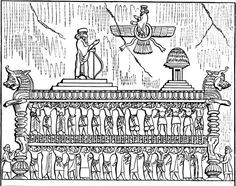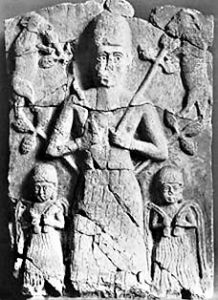(Texts: All Artifacts, Color Coding, & Writings in Bold Type With Italics Inside Parenthesis, are Added by Editor R. Brown, not the Authors, Translators, or Publishers!)
(gods in blue …mixed-breed demigods in teal…)
II Kings, chapters 18 & 19:
“in the fourteen year of the king Hezekiah
Sennacherib, the king of Assyria,
came upon all the walled cities of Judea and captured them …”
the question of whether the Assyrian invasion of Judea was authorized by the lord Yahweh:
“Concerning the king of Assyria…
the way that he came, he shall return;
and unto this city he shall not come in…
for I shall defend this city to save it …”
Quoting the Bible:
“And it came to pass that night,
that the angel of Yahweh went forth
and smote in the camp of the Assyrians
a hundred and eighty-five thousand;
and at sunrise, lo and behold,
they were all dead corpses.
So Sennacherib, the king of Assyria,
departed, and journey back and dwelt in Nineveh…”
Sennacherib failed to conquer Jerusalem…
According to the Old Testament, after Sennacherib returned to Nineveh,
“it came to pass, as he was worshiping in the temple of his god Nisroch,
that Adrammelech and Sharezzer his sons smote him with a sword;
and they escaped unto the land of Ararat.
And Esarhaddon, his son , reigned in his stead…”
The Greek historian Herodotus, who wrote his Histories ca. 450 BC, speaks of a divinely-appointed disaster destroying an army of Sennacherib (2:141):
|
“when Sanacharib, king of the Arabians and Assyrians, marched his vast army into Egypt, the warriors one and all refused to come to his (i.e., the Pharaoh Sethos) aid. On this the monarch, greatly distressed, entered into the inner sanctuary, and, before the image of the god, bewailed the fate which impended over him. As he wept he fell asleep, and dreamed that the god came and stood at his side, bidding him be of good cheer, and go boldly forth to meet the Arabian host, which would do him no hurt, as he himself would send those who should help him. Sethos, then, relying on the dream, collected such of the Egyptians as were willing to follow him, who were none of them warriors, but traders, artisans, and market people; and with these marched to Pelusium, which commands the entrance into Egypt, and there pitched his camp. As the two armies lay here opposite one another, there came in the night, a multitude of field-mice, which devoured all the quivers and bowstrings of the enemy, and ate the thongs by which they managed their shields. Next morning they commenced their fight, and great multitudes fell, as they had no arms with which to defend themselves. There stands to this day in the temple of Vulcan, a stone statue of Sethos, with a mouse in his hand, and an inscription to this effect – “Look on me, and learn to reverence the gods …” |
” |
Forty-six of Hezekiah’s cities (cities 1st millennium BC terms ranged in size from large modern-day towns to villages) were conquered by Sennacherib, but Jerusalem did not fall. His own account of this invasion, as given in the Taylor prism, is as follows:
|
“Because Hezekiah, king of Judah, would not submit to my yoke, I came up against him, and by force of arms and by the might of my power I took 46 of his strong fenced cities; and of the smaller towns which were scattered about, I took and plundered a countless number. From these places I took and carried off 200,156 persons, old and young, male and female, together with horses and mules, asses and camels, oxen and sheep, a countless multitude; and Hezekiah himself I shut up in Jerusalem, his capital city, like a bird in a cage, building towers round the city to hem him in, and raising banks of earth against the gates, so as to prevent escape… Then upon Hezekiah there fell the fear of the power of my arms, and he sent out to me the chiefs and the elders of Jerusalem with 30 talents of gold and 800 talents of silver, and diverse treasures, a rich and immense booty… All these things were brought to me at Nineveh, the seat of my government …” |
” |








